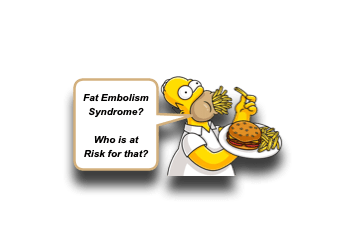Fat Embolism Syndrome in Children

Ok, so maybe Homer has the wrong idea about “Fat Embolism”… I think he should be more worried about a devastating Food Impaction… but, with the Holidays upon us and the prevalence of fatty foods surrounding, me I began to ponder fat embolism and children. (Yes, this is how my warped mind works. When I am at a pool and see a tall, lanky kid, I think of Marfan Syndrome and when I am getting ready to enjoy a little vacation, I think about Fat Emboli.) So for this 525th Ped EM Morsel (THANK YOU ALL FOR THE SUPPORT!), let us consider a critical topic that can lead to sudden devastation and one we should all remain vigilant for: Fat Embolism Syndrome in Children
Fat Embolism in Children: Basics
- Fat Embolism = circulating macroglobules of yellow fat in the systemic and pulmonary microvasculature. [Huffman, 2020]
- Fat Embolism is not uncommon. [Huffman, 2020; Eriksson, 2015]
- Often seen with:
- Orthopedic trauma / procedures (estimated to occur in >90% of patients with the following):
- All long bone fractures
- Multiple fractures
- Intramedullary reaming and nailing
- Hip arthroplasty
- Cosmetic procedures (ex, liposuction)
- Medical conditions (much less often)
- Orthopedic trauma / procedures (estimated to occur in >90% of patients with the following):
- Often seen with:
- Fat Embolism is not the same as Fat Embolism Syndrome [Huffman, 2020; Bailey 2018]
- Most patients with Fat Emboli do not exhibit significant symptoms.
- Only a small percentage will go on to have severe symptoms.
- Fat Embolism Syndrome is the systemic effects due to having Fat Emboli.
Fat Embolism Syndrome
- While most often Fat Emboli are well tolerated, occasionally severe symptoms can occur. [Huffman, 2020; Bailey 2018]
- Symptoms usually develop within 12-72 hours of insulting event.
- Can progress rapidly.
- Fat Embolism Syndrome can affect all organ systems: [Bailey 2018]
- Respiratory (ex, distress, overt failure)
- Neurologic (ex, confusion, seizures, coma)
- Hematologic (ex, anemia, thrombocytopenia)
- Cutaneous (ex, petechiae)
- Renal (ex, acute renal failure)
- Ocular (ex, conjunctival petechiae, retinopathy)
- ** Hallmarks are typically Respiratory Distress with Altered Mental Status and Petechiae! (clearly a number of other items exist on this Ddx list).
- The exact pathophysiology is not clear, but believed to have 3 inter-related mechanisms: [Huffman, 2020; Bailey 2018]
- Mechanical Theory: fat emboli lead to thrombotic, obstructive mass (similar to pulmonary embolism)
- Biochemical Theory: degradation of fat emboli leads to free fatty acids and subsequent inflammatory cascade and results in injury to pneumocystis and small capillaries (similar to ARDS)
- Coagulation Theory: released thromboplastin and marrow activate complement cascade and eventual intravascular coagulation with platelets adhering to fatty emboli.
- Recognition of Fat Embolism Syndrome is challenging. [Huffman, 2020; Bailey 2018]
- Diagnosis is really one of exclusion.
- There are several scoring criteria, but none have been validated and all utilize nonspecific findings.
- Examples:
- Gurd and Wilson’s Criteria: (1 Major + 4 Minor)
- Major Criteria
- Petechial Rash
- Respiratory insufficiency
- Cerebral involvement (altered mental status)
- Minor Criteria
- Tachycardia, Fever,
- Jaundice, Retinal changes, Renal signs
- Lab Values
- Thrombocytopenia
- Anemia
- High ESR
- Fat Macroglobulinemia
- Major Criteria
- Schonfeld’s Critieria: (Score >5)
- Petechiae = 5 pts
- CXR with diffuse infiltrates = 4 pts
- Hypoxemia = 3 pts
- Fever, Tachycardia, Tachypnea, Confusion all get 1 pt respectively
- Gurd and Wilson’s Criteria: (1 Major + 4 Minor)
- These obviously do not work for a patient who is intubated (as the respiratory distress and altered mental status are difficult to discern). [Huffman, 2020]
- Huffman et al. recommend using Oxygenation Index (OI)
- OI= (Mean Airway Pressure x FIO2 x 100) / PaO2.
- Normal OI = 0.
- OI > 0 indicates some level of pulmonary / respiratory dysfunction
- Once again, this clearly does not define the condition on its own.
- Huffman et al. recommend using Oxygenation Index (OI)
- Imaging: [Bailey 2018]
- CXR and CT will show bilateral infiltrates.
- May appear similar to ARDS.
Fat Embolism Syndrome & Sickle Cell Disease
- Fat Embolism Syndrome is a potential complication seen with Sickle Cell Disease. [Bailey 2018]
- Believed to be due to the acute infarction and necrosis of bone.
- Along with infection, this is one of the identifiable causes of Acute Chest Syndrome.
- Contributes significant mortality!
- May have up to 38% mortality in first 24 hours.
- Leads to rapid deterioration.
- Consider possibility of Fat Embolism Syndrome in patients with Sickle Cell Disease and [Bailey 2018]
- Acute Chest Syndrome
- Severe Vaso-occlusive Crisis unalleviated with increasing doses of analgesics.
Fat Embolism Syndrome: Management
- There is no specific treatment for Fat Embolism Syndrome. [Bailey 2018]
- Supportive care is the main strategy. [Bailey 2018]
- Pulmonary toilet and respiratory support
- Vasopressor support when needed
- May present with Obstructive Shock
- Excessive volume resuscitation should be avoided
- May want to use Echocardiogram to help guide fluid management.
- May need to consider ECMO.
- Heparin has been debated, but not currently recommended… of course it may be started as the clinical picture may be unclear.
Moral of the Morsel
- Balls of Fat are Bad. Sure fat may make your steak taste delicious, but a bolus of free fatty acids in small capillaries can be deadly!
- Keep asking “why?” Why is the patient not improving? Why did this patient have such terrible respiratory distress after a straight forward femur fracture? The question may lead to Fat Embolism Syndrome as an answer.
- Sickle Cell Disease is TERRIBLE! Infarction of the bone by your own blood is cruel… and apparently can lead to Fat Emboli!

